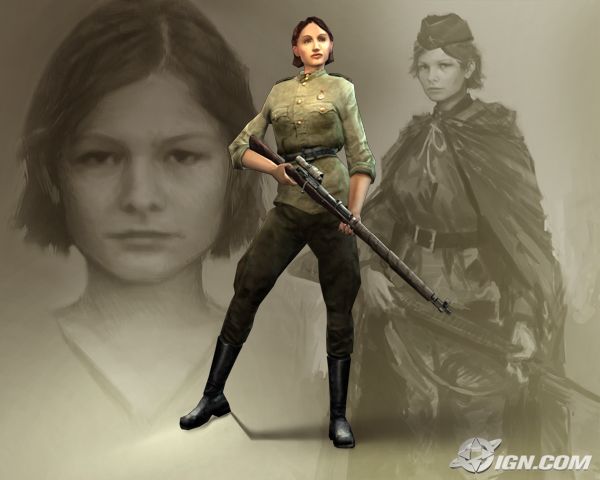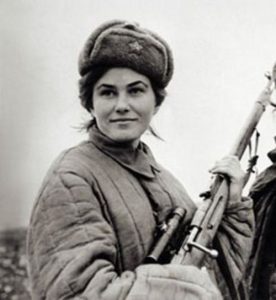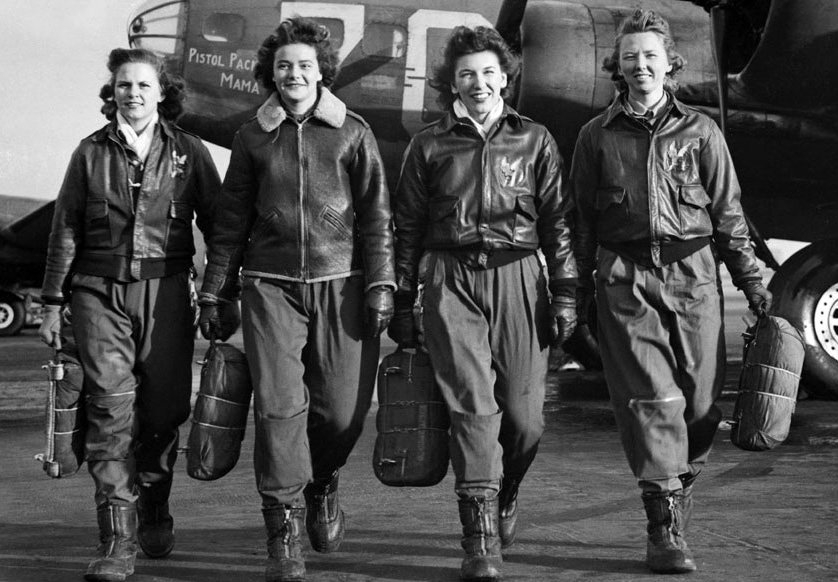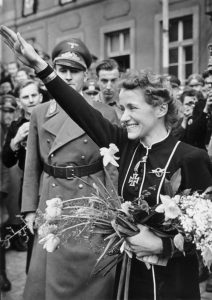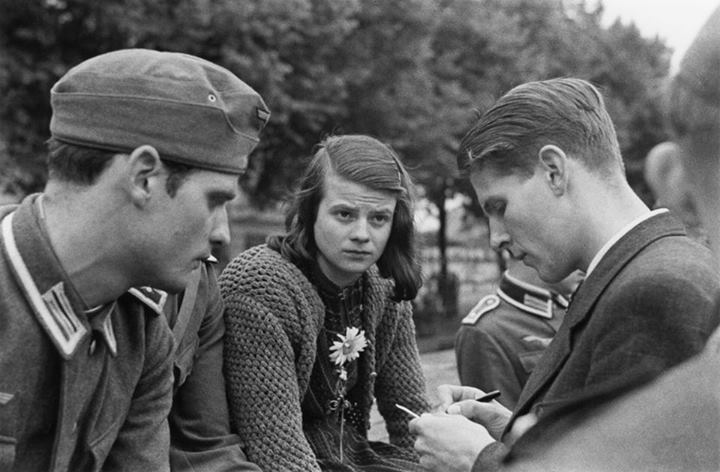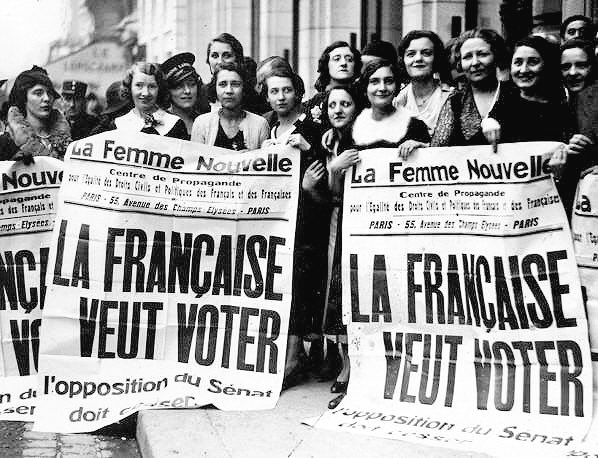When it comes to representation of women in gaming, Call of Duty has always had a spotty record. There was a playable female character as early as the second game in the series (Finest Hour, not Call of Duty 2) in 2004. After that, it wouldn’t be until Black Ops II’s zombie mode in 2012 that we saw another such unicorn.
But in terms of military shooters, Call of Duty has somehow found itself at the forefront. With only one playable woman character per game, compared to countless dudes with the same beard, it’s hard to fear like you’re playing any kind of feminist manifesto. In that regard, Call of Duty: WWII is something of a breath of fresh air. While the campaign features one playable female character compared to three or four men, there are two in the zombie mode (and Ving Rhames), and countless women in the multiplayer mode, including women of color.
While the lone woman in Call of Duty: WWII is a resistance fighter, there were women enlisted in several armies around the world. Call of Duty first foray into console gaming with Finest Hour gave us a look at the legendary Russian women snipers with Tanya Pavelovna.
The Romance of the Sniper
While most of the world still doesn’t allow women to serve in combat roles in the military, Russia has long stood as a defiant light. As of 2013, 29,000 women currently serve in the Russian military, 900 of whom are officers. That number was obviously much more significant during World War II, at an estimated 800,000, which was still only 8% of the Soviet Union’s armed forces. While many of these women were medics or radio operators, a significant portion of them served as front line troops – snipers, machine gunners, pilots, and tank operators.
The image of the female Soviet sniper is as iconic in Russia as cowboys are in the United States. It’s the first thing you think of when you think women in the Soviet army, certainly the first thing developer Spark Unlimited thought of when they created Tanya Pavelovna in Finest Hour. But only about 2,000 of those women were snipers. So why do we associate these women with sniping?
The idea of sniper is itself a romantic notion. A single person, or maybe two with a spotter, sitting in a single location for hours or even days, stalking a target and waiting for the perfect moment to strike. The old adage is that women are better suited to sniping than men, due to the natural patience, can endure cold and stress better than men, have smaller hands, and other well-trodden stereotypes. That’s what the Soviet Union thought anyway, and a vast majority of their snipers were women.
Lady Death
Pavelovna was clearly inspired by Tania Chernova from 2001’s Enemy at the Gates, even sharing a first name, if spelled differently. But Spark Unlimited how 2,000 examples to draw upon. Obviously we can’t cover them all, but we will take a look at one of them.
Like Lyudmila Pavlichenko, aka “Lady Death.” Born in modern day Ukraine, Pavlichenko volunteered for the army the day Germany invaded the Soviet Union, requesting to be placed in the infantry. She was assigned to the 25th Rifle Division as a sniper, and got her first two kills two months after joining. Over the course of the war, Pavlichenko fought in the Sieges of Odessa and Sevastopol, and racked up a confirmed kill count of 309 from August 1941 to June 1942.
In June 1942, she was wounded by a mortar round. She quickly recovered, but due to her status as an icon, the Soviet government removed her from combat and set her on a tour of Allied nations. While in the US, she befriended First Lady Eleanor Roosevelt, whom she toured the US with. After her literal tours, she returned to the Soviet Union in 1943 and was assigned as an instructor role. She never returned to combat, but after just one year, she became the deadliest female sniper in history, a title she still holds.
Women in the US Army Air Corps and Navy
In the United States, women joined the military as nurses, radio operators, and secretaries. They were allowed near the front lines, but some were allowed to join the Air Corps or the Navy in different roles.
Known as the Women Airforce Service Pilots (or WASP’s), these pilots were not trained for combat, instead they would flew in training missions, carried cargo, and transported planes from one location to another. Of the some 25,000 women to apply during the war, less than 1,900 were accepted.
Another prominent branch were the WAVES, or the Women Accepted for Volunteer Emergency Service of the United States Naval Reserve. You can see why they went with WAVES. Much like the WASP’s, these women filled the roles at home left vacant by the men fighting overseas. They were aviation mechanics, parachute riggers, radio operators, yeoman, and control tower operators.
Navy Black and Blue
Frances Wills, a Philadelphia native and adoption agent, and Harriet Ida Pickens, a public heath administrator, were the first African-American officers in the military by serving in the WAVES. The two graduated from the Naval Reserve Midshipmen’s School at Northampton, Massachusetts in December 1944. Previously, US Secretary of the Navy Frank Knox said that African Americans would only enter the WAVES program “over his dead body.” Oh, how we tempt fate. Only two years after uttering those words, Knox died of a heart attack and was replaced by James Forrestal, who accepted African Americans to join the WAVES with open arms, leading to Frances Wills and Harriet Ida Pickens acceptance and eventual promotion.
As officers, Wills and Pickens worked as trainers at Hunter Naval Training Station in New York. While visiting a shipyard in Brooklyn, Wills was greeted by other women of color standing in awe at the sight of an African-American officer. She recounts the story in her memoir, Navy Blue and Other Colors:
“It was the first time that these stewards (the only job available for many years for Afro-Americans in the Navy) had seen a person of color in officer’s uniform. It may well have been the first time they had seen WAVES of any color since they had just returned from duty.”
Ack-Ack Girls
Starting in 1941, the UK called forward all un-married when between the ages of 20 and 30 to serve in one of four home-based services – the Auxilliary Territorial Service (ATS), the Women’s Auxiliary Air Force (WAAF), the Women’s Royal Naval Service (WRNS), or the Women’s Transport Service (WTS). All these services operated at home, and consisted of jobs such as patrolling the coastline, acting as couriers, and operating anti-aircraft guns.
The women who served on the guns, known as “Ack-Ack guns,” were thus dubbed “Ack-Ack Girls.” Some 731 women were killed working this role, and others in the various auxiliary corps. The Ack-Ack Girls in particular had it difficult, as while they weren’t supposed to serve on the front line, their role shattered any such illusion.
Throughout the war, especially during the Battle of Britain in mid-to-late 1940, the German Air Force (Luftwaffe) bombed several civilian centers throughout the UK. Despite an extensive radar network, the RAF (Royal Air Force) couldn’t always arrive in time to fight off the bombers. These situations called for anti-aircraft guns, and the Ack-Ack Girls to shoot the bombers and fighters down.
Mary Latham, an ATS member stationed in an anti-aircraft crew, recounts a story of a similar crew in the war.
“At Caister, near Yarmouth, 25 ATS’s were killed by machine-gun fire. The enemy aircraft flew over in the early morning at sunrise, when it was impossible to see them and peppered the coast with gun-fire. It was a frightening sight to see Focke Wulfs diving down while we tried to pay our respects, standing to attention during the playing of the Last Post, to those who had been killed.”
Nazism Can Take Many Forms
It’s an unfortunate fact that Nazism isn’t an exclusively male ideal. The German military saw its fair share of female soldiers, pilots, and spies, all willing contributors to the Nazi war effort. For the majority of the war, women weren’t allowed any official position within the military, until Germany became desperate in 1943 and allowed women to play a more active role in auxiliary units. By 1945, 500,000 were members of the Wehrmacht, and several thousand more in the SS. As early as 1942, women began serving as guards at Majdanek and Auschwitz. When the war was over, some 3,700 women served as guards at concentration camps. Some were conscripted, but many others volunteered.
Many of these guards, such as Jenny-Wanda Barkmann, were tried and executed for war crimes. Barkmann was said to giggled and flirted with the guards throughout her trail, saying that her life had been a pleasure when she was given the death penalty.
Another proud Nazi woman was Hanna Reitsch, a decorated test pilot who proposed Germany should start using Japanese-style Kamikaze attacks. While she didn’t serve in combat, she did test some of the Nazi’s most dangerous planes, including one of the world’s first helicopter designs in 1939, and the rocket-powered Messerschmitt 163 in 1944, which was by far the fast plane in the world at the time.
#NotallGermanWomen
Don’t be sad about any of that. Remember, puppies exist! And so do Maria von Maltzan, Sophie Scholl, and Elise Hampel, all German born Nazi ass-kickers. None of them were soldiers, and they didn’t fight like any of the other women we’ve featured in these articles so far. But it’s worth pointing that sometimes there are more powerful weapons than guns. And also Nazi’s are shit.
Sophie Scholl was a member of the White Rose resistance group, a non-violent protest movement protesting the war and government. She and other members of the group passed out fliers and leaflets at universities, and publicly spoke out against the government. In February 1943, she and her brother were found guilty of treason, and were later executed via guillotine. The story of Elise Hampel is almost identical. She and her husband, Otto, left anti-Hitler postcards in public places throughout Berlin. They too were found, arrested, and beheaded.
Maria von Maltzan was a countess who used her wealth and status to hide and feed Jews, deserters, and escaped prisoners. She falsified documents, and smuggled them out of Germany herself. In October 1944, she was on a mission to smuggle several Jewish residents out of Berlin via train when something went wrong. With an agreement in place with the Church of Sweden and German rail workers, von Maltzan swapped out crates of furniture for the Jews she was escorting. She smuggled them out successfully, but on her way back, she ran into SS men who were looking for her, with spotlights and dogs. She went into the woods, smeared horse manure and waded through streams to throw the dogs off her scent, and hid up a tree for two days.
The Tip of the Iceberg
After two articles, we’ve barely even scratched the surface of female soldiers who fought in World War II, let alone the countless other women who resistance oppression and tyranny in other ways every single day.
Millions participated in the war as nurses, soldiers, pilots, factory workers, mothers, and sisters. All of them fought for their countries, their loved ones, and their ideals. Some of them even fought for nations that didn’t let them vote, like France who didn’t pass women’s suffrage until after the Allies liberated Paris in 1944, or in Bulgaria when it took the overthrow of the government, also in 1944.
Before you go grab Call of Duty: WWII (or don’t), why not spend some time looking into these women, or any of the countless others who sacrificed so much in the war that never get the attention they deserve. Having Rousseau not only be in the game, but also a playable character is a nice first step, but gaming should be well past its first baby step when it comes to representation. Perhaps that’s the attitude that carried many women through the war: “I better role up my sleeves and get to work, because nobody else is going to do it.”
Josh Griffiths
Latest posts by Josh Griffiths (see all)
- The War Stories Battlefield V is Missing - November 12, 2018
- Horizon Zero Dawn Shows the Problem with Game Reviews - November 7, 2017
- Call of Duty WWII’s Missed Opportunities and Future Possibilities - November 3, 2017

